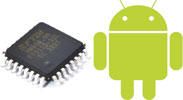

FTDI is supporting the Android Open Accessories initiative with the introduction of its FT311D, a USB Full-Speed (12 Mbps) host IC specifically targeted at providing Android platforms, such as tablet PCs or smartphones, with interconnectivity to end-product systems through the utilisation of USB technology.
Google unveiled the Android Open Accessories initiative a little over a year ago. The specification uses industry standard USB technology with an additional enumeration step. As a result the USB connection allows the Android platform to function as a USB slave/peripheral.
This eliminates the need to source power, store class drivers, and support the USB host stack, which has responsibility for controlling the USB bus. In the end, the USB host functions are now relegated to the end-product which is connecting to the Android platform.
Running off a standard 3,3 V supply and drawing a current of just 25 mA in full operation at 48 MHz (only 128 μA while in standby mode) the FT311D has the capacity to bridge the USB port to six different user-selectable interface types, namely GPIO, UART, PWM, I²C master, SPI slave and SPI master.
It can be utilised in conjunction with any platform that supports the Android Open Accessory mode (typically Version 3.1 of the Android operating system onwards, though some platforms may back-port Open Accessory mode to Version 2.3.4).
When the IC’s peripheral interface is configured in UART mode, the interface implements a basic asynchronous serial UART port with flow control. The UART can support data rates of between 300 bps and 6 Mbps, while its I²C master interface can connect to I²C slave interfaces supporting speeds of up to 125 kbps.
The interface can also be configured to provide four pulse width modulation (PWM) outputs. These can be used to generate PWM signals for controlling the motors, actuators, sensors, DC/DC converters and AC/DC supplies found in such systems as toys, lighting applications, home automation and industrial equipment.
A development module (UMFT311EV) based on the FT311D is also available. With board dimensions of 68,58 x 55,38 x 14,00 mm, this is intended for use as a hardware platform to enable easy evaluation of the IC and allow engineers to develop a broad range of Android Open Accessory compliant applications.
Selection of the desired interface mode is done using a series of jumpers. This module is complemented by a 66,60 x 55,38 x 22 mm form factor GPIO shield board (UMFT311GP), which has a pushbutton keypad that acts as a user input and a set of 8 LED emitters which can be deployed to illustrate an active output.
The FT311D is supplied in 32-pin QFN and LQFP package options, and has an operational temperature range that covers -40°C to 85°C.
For more information contact Electrocomp, +27 (0)11 458 9000, [email protected], www.electrocomp.co.za
| Tel: | +27 11 458 9000 |
| Email: | [email protected] |
| www: | www.electrocomp.co.za |
| Articles: | More information and articles about Electrocomp |

© Technews Publishing (Pty) Ltd | All Rights Reserved